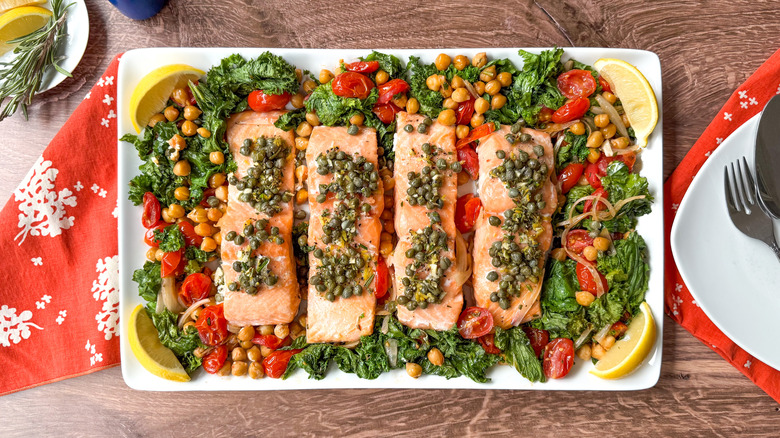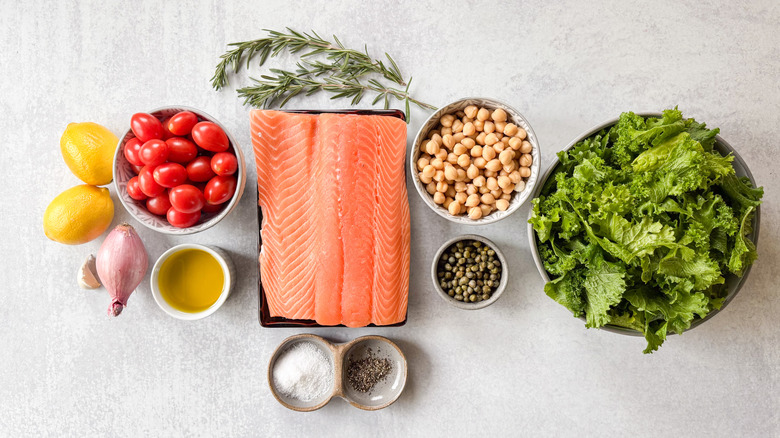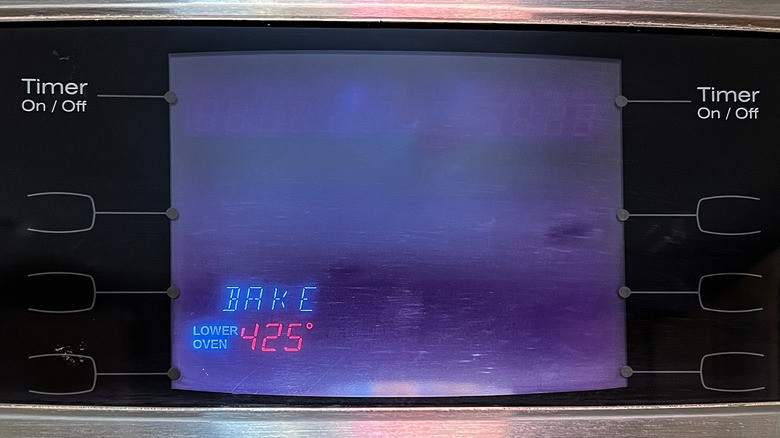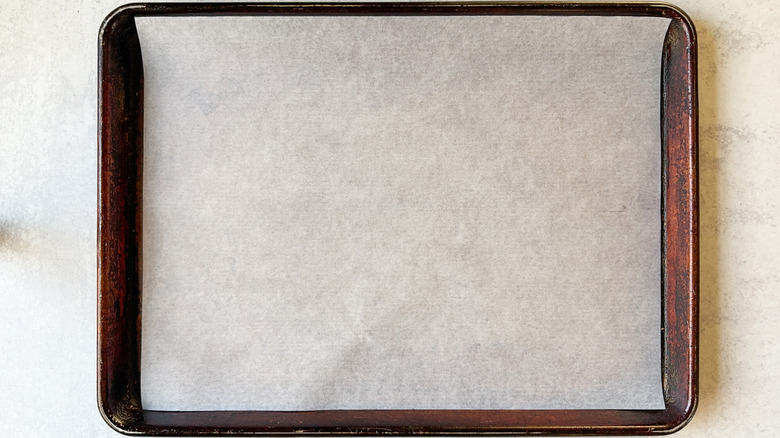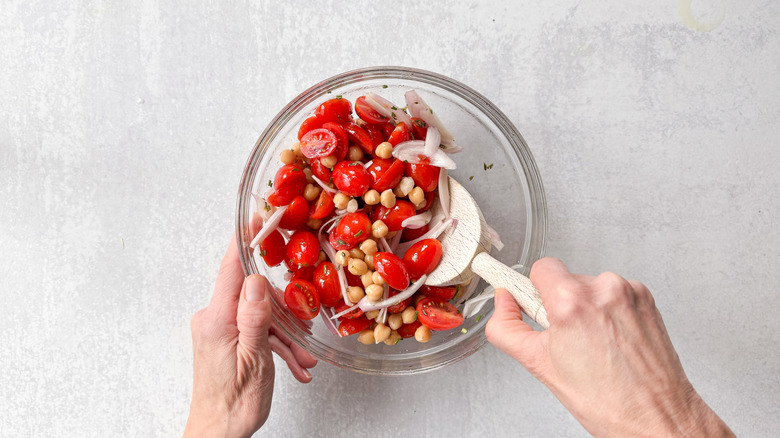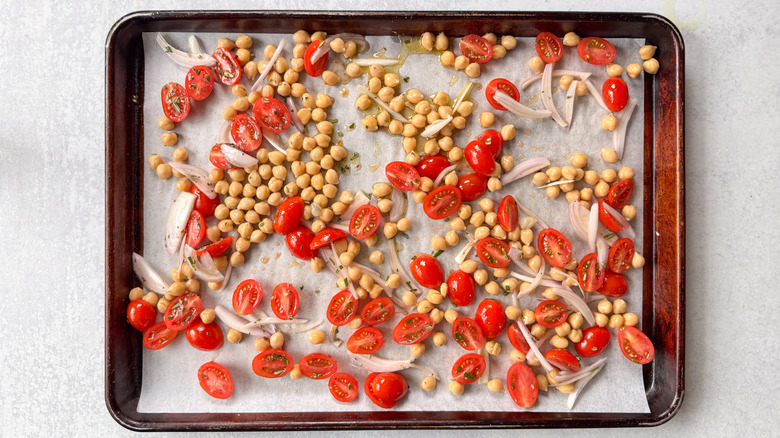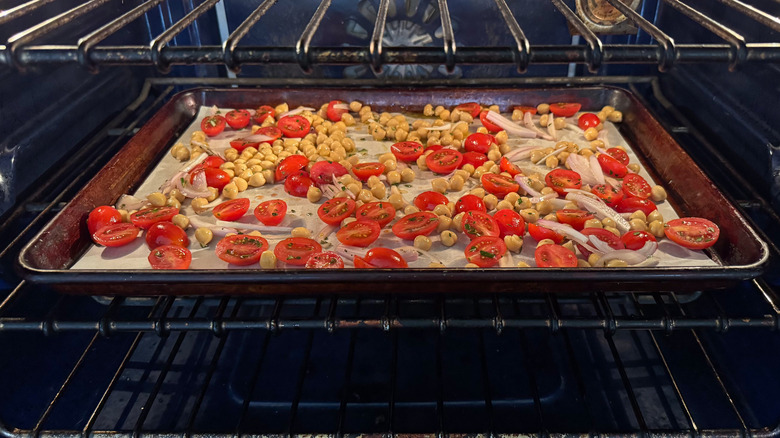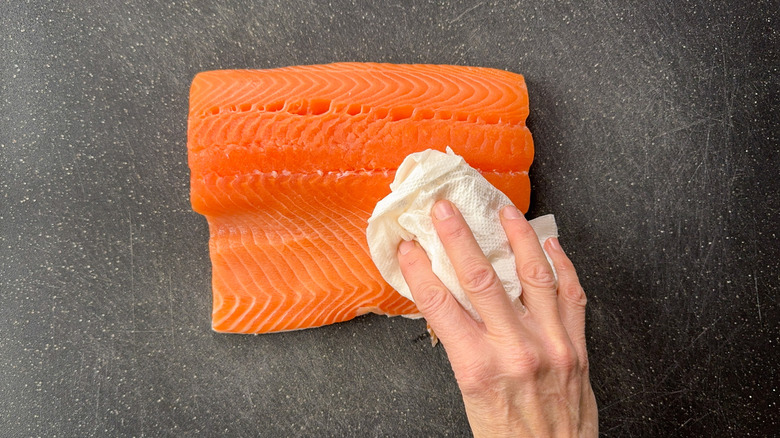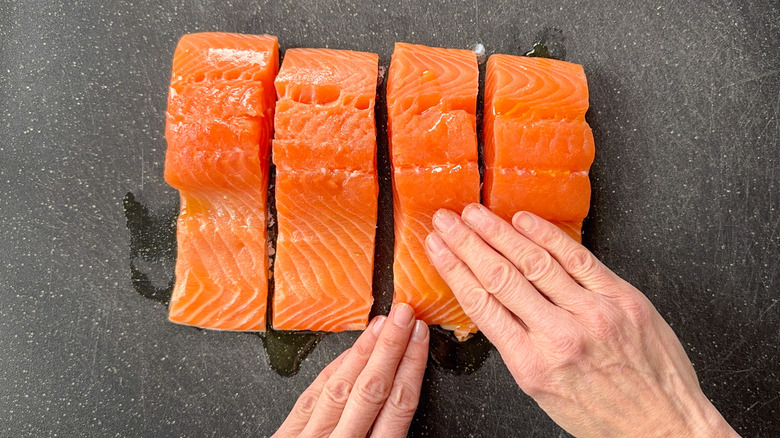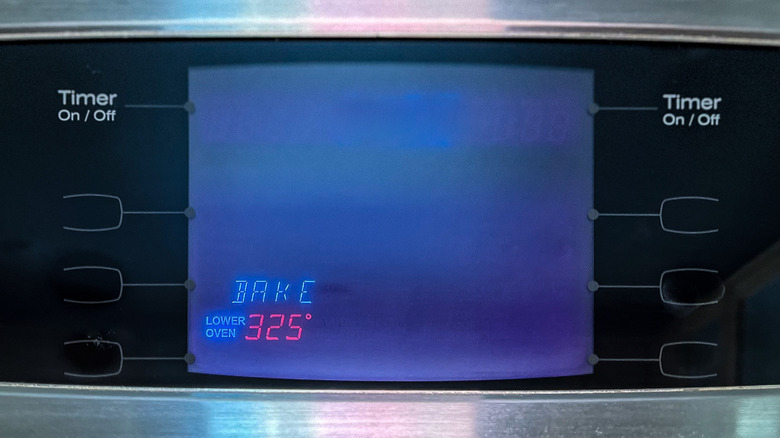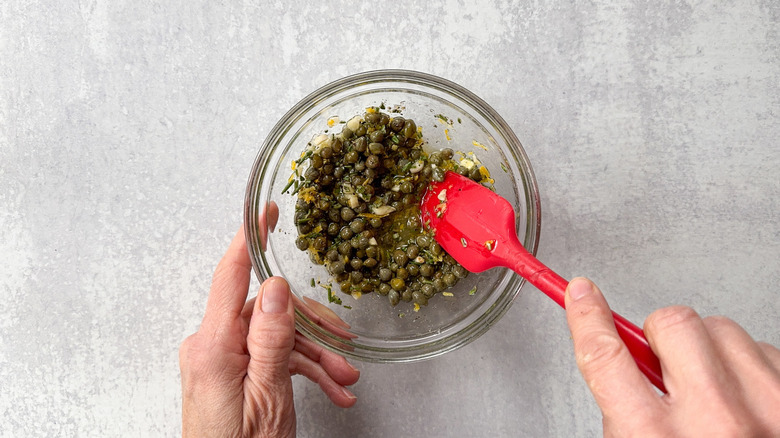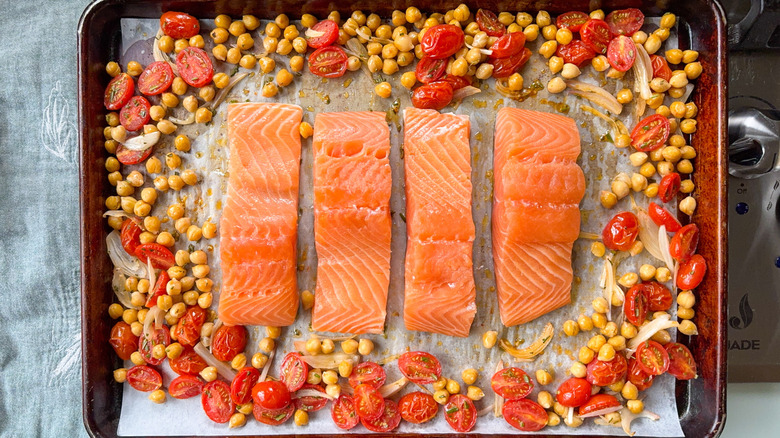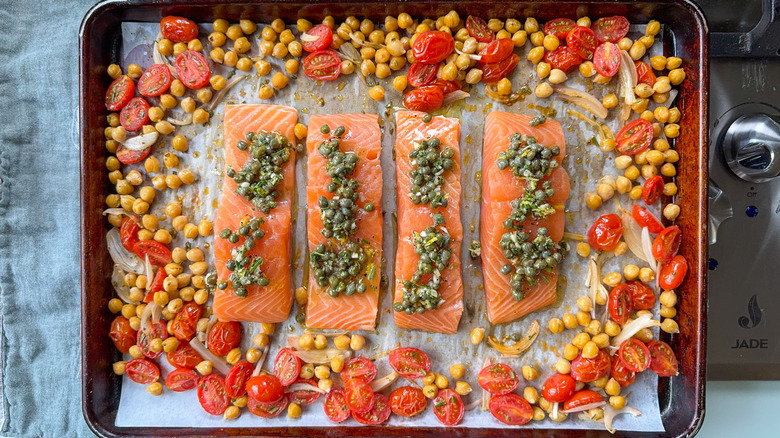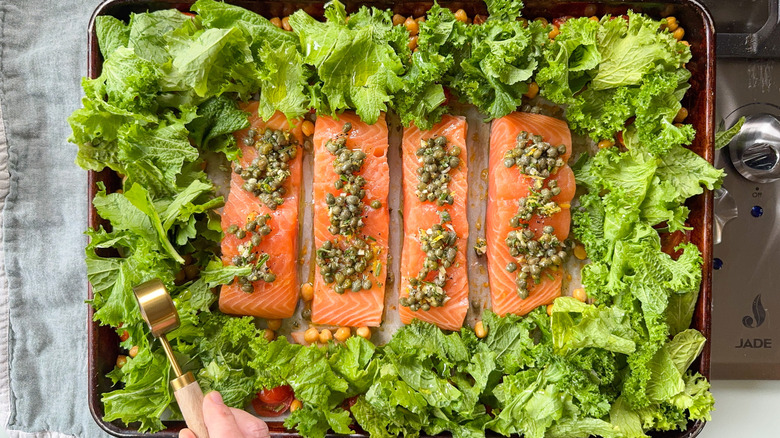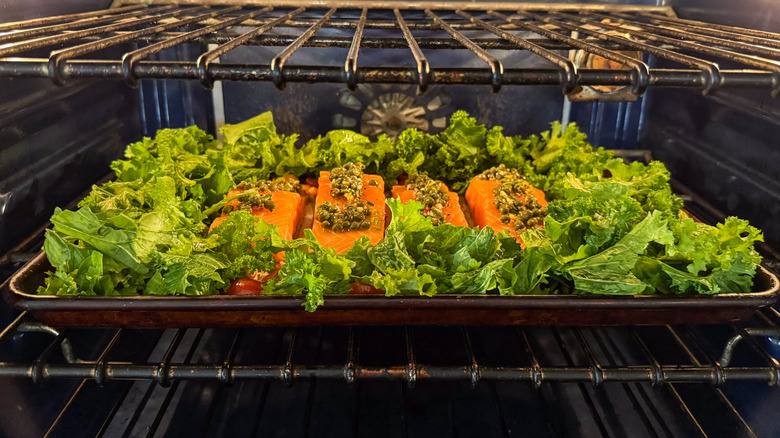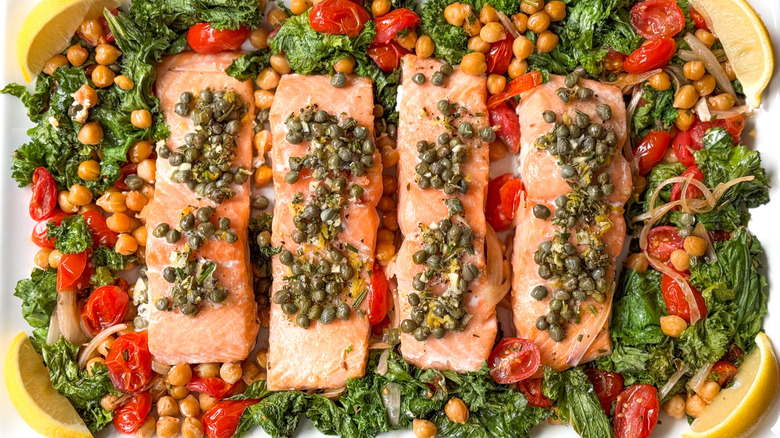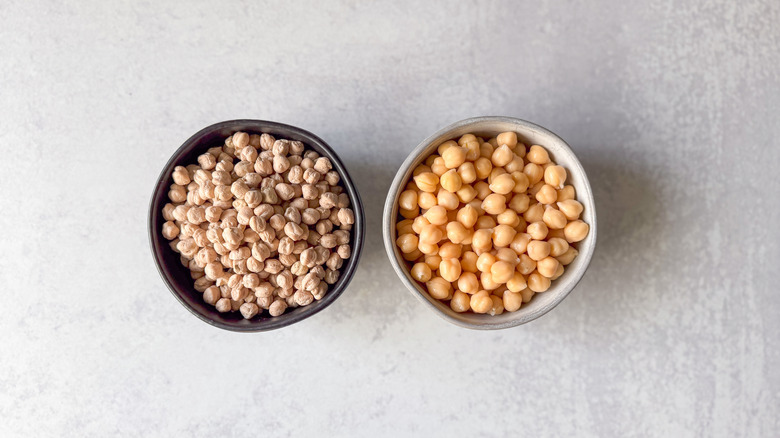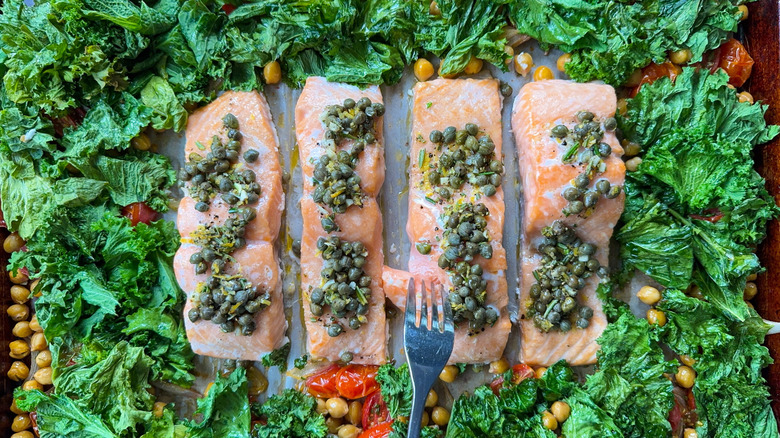1-Pan Baked Salmon With Mustard Greens And Chickpeas Recipe
Salmon is one of the most popular fish varieties to prepare and enjoy, and for good reason. Poached, grilled, baked, or raw, salmon can be the star of delicate dishes yet has the right texture and flavor to hold up to spice and more assertive flavors. This recipe for one-pan baked salmon with mustard greens and chickpeas, courtesy of recipe developer Julie Kinnaird, turns skin-on salmon fillets into a zesty and colorful meal, one full bold Mediterranean flavors like capers, lemon, tomatoes, and rosemary. The salmon, chickpeas, and mustard greens all roast together for an easy-to-prepare yet elegant meal any day of the week.
Avoiding certain mistakes when cooking salmon will help you make this most out of this dish. Start with the best quality salmon you can find, whether that is wild-caught or reputably farm-raised. Look for good color and a fresh, not overly fishy aroma. Keep the skin on for this recipe but check for and remove any pin bones before proceeding. We'll touch more on cooking the fish to the perfect temperature later on, so you can guarantee a successful one-pan meal from start to finish.
Gather the 1-pan baked salmon with mustard greens and chickpeas ingredients
The star of this recipe is a fresh and thick center-cut skin-on salmon fillet. The skin is left on because it helps to keep the salmon intact while cooking, plus allows additional flavor and fat to melt into the meat. The salmon is baked on a sheet pan with a mixture of canned chickpeas, grape tomatoes, shallot, extra-virgin olive oil, and fresh rosemary. You will top the salmon with a mix of drained capers in brine, lemon zest and juice, chopped fresh garlic, and salt and pepper. The last step is arranging fresh mustard greens around the salmon. The mustard greens add a peppery and slightly bitter and bright flavor, which serves as a nice contrast to the fatty salmon.
Step 1: Preheat the oven
Preheat the oven to 425 F.
Step 2: Prepare a baking sheet
Line a rimmed baking sheet with parchment paper.
Step 3: Combine the chickpeas, shallot, tomatoes, and seasonings
In a medium bowl, combine the chickpeas, shallot, tomatoes, 2 tablespoons olive oil, 2 teaspoons rosemary, and 1 teaspoon sea salt.
Step 4: Transfer the chickpea mixture to the baking sheet
Transfer the chickpea mixture to the baking sheet.
Step 5: Bake the chickpeas
Bake for 10 minutes.
Step 6: Rinse and dry the salmon
While the chickpeas are baking, rinse and pat dry the salmon fillet.
Step 7: Cut the salmon into portions
Cut the salmon into 4 equal portions and rub with 1 tablespoon olive oil.
Step 8: Reduce the oven temperature
Remove the chickpeas from the oven and reduce the temperature to 325 F.
Step 9: Mix the topping for the salmon
In a small bowl, combine the capers, 2 tablespoons olive oil, lemon zest, lemon juice, remaining 2 teaspoons of rosemary, garlic, remaining teaspoon of sea salt and the pepper.
Step 10: Add the salmon to the baking sheet
Push the chickpea mixture to the sides of the baking sheet and place the salmon skin-side-down in the center of the pan.
Step 11: Add the caper topping
Top the salmon with the caper mixture.
Step 12: Add the mustard greens
Arrange the mustard greens around the salmon and drizzle with the remaining tablespoon of olive oil.
Step 13: Bake the salmon
Bake the salmon for about 15 minutes, just until it flakes and is still opaque in the center.
Step 14: Serve the salmon with the mustard greens and chickpeas
Serve the salmon, mustard greens, and chickpeas on a platter with lemon wedges on the side for squeezing.
1-Pan Baked Salmon With Mustard Greens and Chickpeas Recipe
This one-pan dinner dish features tender salmon, mustard greens, cherry tomatoes, chickpeas, and a zesty caper sauce to top it all off.
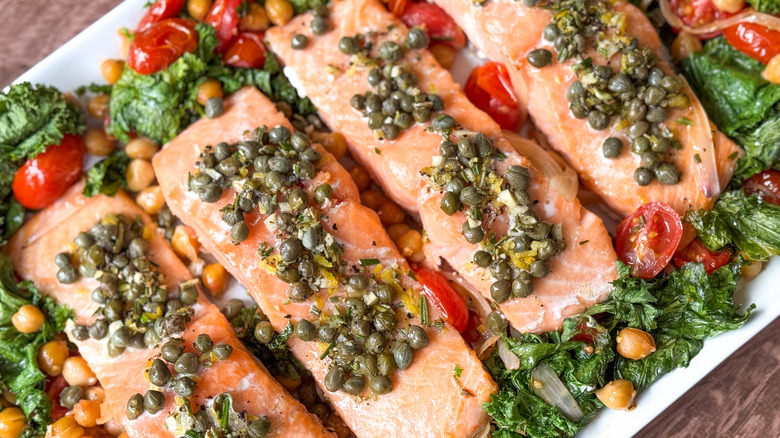
Ingredients
- 1 (15-ounce) can chickpeas, drained and rinsed
- 1 large shallot, thinly sliced
- 2 cups grape tomatoes, halved
- 6 tablespoons extra-virgin olive oil, divided
- 4 teaspoons chopped fresh rosemary leaves, divided
- 2 teaspoons sea salt, divided
- 1 ½ pounds skin-on, center-cut salmon fillet
- ¼ cup capers in brine, drained
- 1 tablespoon chopped lemon zest
- 1 tablespoon fresh lemon juice
- 1 large clove garlic, chopped
- ½ teaspoon freshly cracked black pepper
- 6 cups fresh mustard greens, tough stems removed, torn into smaller pieces
- 1 small lemon, cut into wedges
Directions
- Preheat the oven to 425 F.
- Line a rimmed baking sheet with parchment paper.
- In a medium bowl, combine the chickpeas, shallot, tomatoes, 2 tablespoons olive oil, 2 teaspoons rosemary, and 1 teaspoon sea salt.
- Transfer the chickpea mixture to the baking sheet.
- Bake for 10 minutes.
- While the chickpeas are baking, rinse and pat dry the salmon fillet.
- Cut the salmon into 4 equal portions and rub with 1 tablespoon olive oil.
- Remove the chickpeas from the oven and reduce the temperature to 325 F.
- In a small bowl, combine the capers, 2 tablespoons olive oil, lemon zest, lemon juice, remaining 2 teaspoons of rosemary, garlic, remaining teaspoon of sea salt and the pepper.
- Push the chickpea mixture to the sides of the baking sheet and place the salmon skin-side-down in the center of the pan.
- Top the salmon with the caper mixture.
- Arrange the mustard greens around the salmon and drizzle with the remaining tablespoon of olive oil.
- Bake the salmon for about 15 minutes, just until it flakes and is still opaque in the center.
- Serve the salmon, mustard greens, and chickpeas on a platter with lemon wedges on the side for squeezing.
Nutrition
| Calories per Serving | 743 |
| Total Fat | 46.7 g |
| Saturated Fat | 8.3 g |
| Trans Fat | 0.0 g |
| Cholesterol | 93.6 mg |
| Total Carbohydrates | 37.3 g |
| Dietary Fiber | 12.1 g |
| Total Sugars | 9.5 g |
| Sodium | 1,179.3 mg |
| Protein | 46.3 g |
What are chickpeas and what do they add to this dish?
Chickpeas (also known as garbanzo beans) are a key ingredient in popular Mediterranean foods like hummus and falafel, and are found in curries, soups, stews, and a variety of salads. Chickpeas are also widely used in ground form for high-protein breads and pastas. Loaded with a variety of nutrients, such as iron, calcium, zinc, fiber, and protein, chickpeas enhance nearly every meal they grace with a subtle nutty flavor profile.
When it comes to using chickpeas in culinary preparations, you can choose from the dried or canned form. Dried chickpeas require soaking and a longer cooking time, making canned chickpeas an attractive option to have on hand in your pantry. It is best to always rinse canned chickpeas to remove excess sodium and starch. Chickpeas have a robust texture that allows them to become crunchy when roasted, yet soft enough to become pureed. The nutty flavor of the baked chickpeas in this recipe is a perfect contrast to the rich salmon flavor and bitter greens.
Why is the salmon baked at a lower temperature in this recipe?
If you are wondering about the 100-degree temperature drop mid-recipe, there is a good reason behind this oven shift. Salmon has a tendency to quickly go from luxurious and moist to dry and chalky when baked at temperatures typically used for meats. Kinnaird says that roasting the salmon at a low temperature allows the fats to gently melt into the flesh, rather than escaping when protein strands contract under high heat. A lower oven temperature allows proteins to have more time to denature, or unwind gradually. This retains more moisture in the fish and keeps the salmon tender rather than becoming dry and overly flaky.
If you have ever cooked a piece of salmon and noticed a gloopy white substance leaking from the flesh, you have likely overcooked your fish. Slow-roasting salmon or cooking by other low heat methods such as poaching help to avoid excessive amounts of this white stuff, albumin, from escaping the flesh. The result is a cooked-through, flaky, tender salmon fillet that doesn't taste at all dry or overdone.
